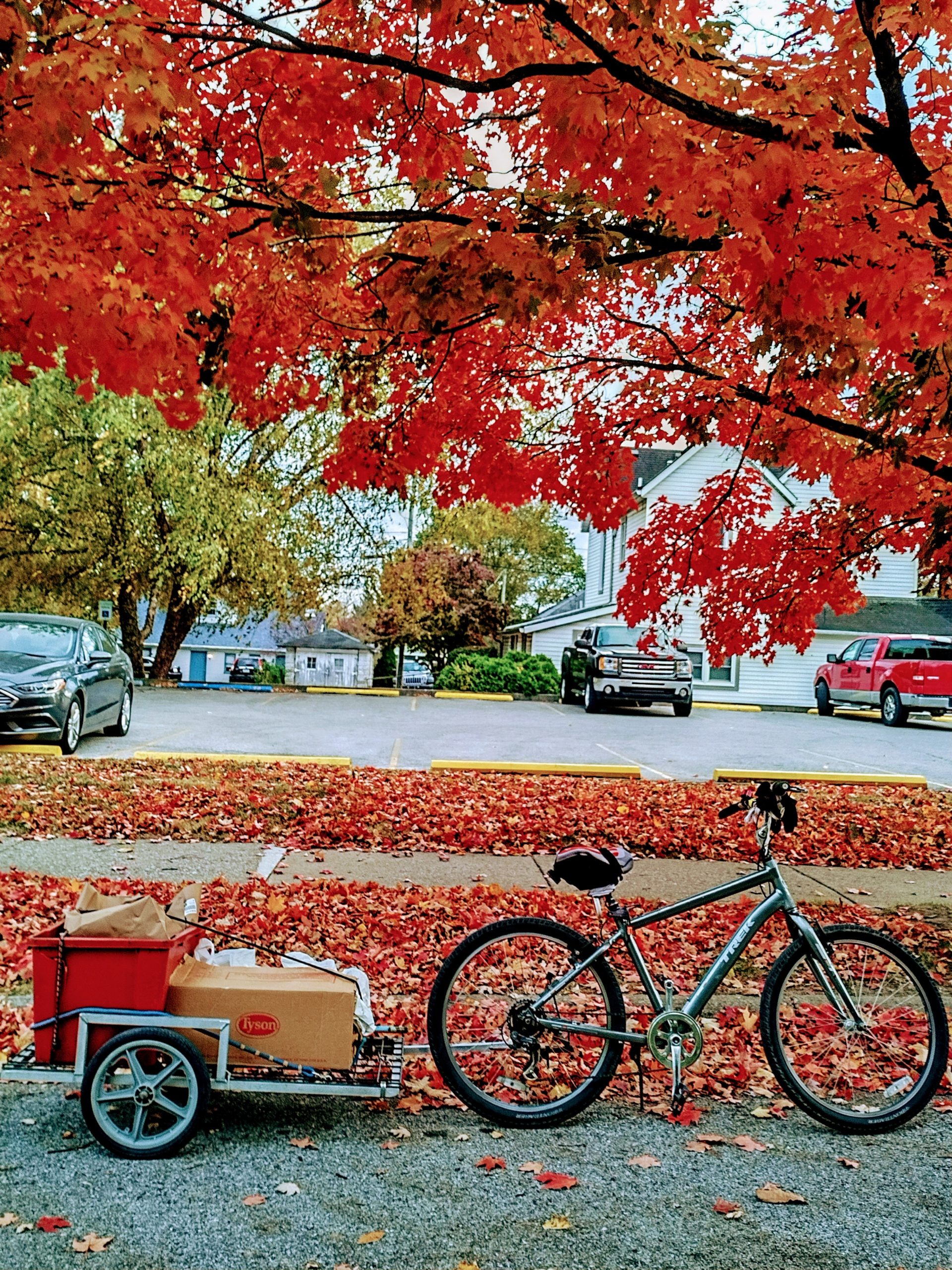Podcast: Play in new window | Download (Duration: 27:49 — 38.3MB)
Subscribe: RSS
Today on Eco Report, Environmental Correspondent Zyro Roze asks Hank Duncan, the City’s Bicycle Pedestrian Coordinator, about recent changes in local infrastructure to address E-scooter misuse and other challenges relating to access for the disabled and providing alternative transit options for Bloomington residents and visitors.
And now for your environmental reports:
Columbus Looking at $2.3 million Solar Project at Wastewater Plant

Columbus City Utilities is planning a solar project at its wastewater plant with an estimated price tag of $2.3 million, though a tax credit is expected to lower the cost by around 30%.
We are looking at installing solar panels on our property at the wastewater treatment plant, said utilities engineer Ashley Getz. The array will be located west of the plant and be just under 2.5 acres.
According to CCU Executive Director Roger Kelso, the solar array will be located in a field that is utilities property, and they will not need to acquire additional ground for the project.
The one-megawatt system will allow CCU to cut energy purchasing at the plant by 30%, Getz said. It’s expected this will save them $140,000 for the first year. Savings in future years will depend on how much the cost of electricity increases over time.
-Norm Holy
‘Indiana Bats Appear to be Thriving’ at Vermont Colony

There’s hope for the Indiana bat. A colony has been found in Vermont. The bats’ habitat, a 301-acre public forest, was conserved when the colony was discovered nearly 20 years ago — just before the onset of the devastating white-nose syndrome. While bats elsewhere have struggled to rebound, the Indiana bats in Hinesburg, Vermont appear to be thriving.
To wildlife experts, the colony’s resilience is a testament to how conservation and good land management can help restore a species on the brink.
When the bats were discovered in Hinesburg in 2006, it marked the farthest point north and east that the species had ever been found. Members of the Hinesburg Land Trust and other conservation groups worked with state and federal officials to purchase the land, which was being sold by a longtime farming family, and succeeded in 2007, permanently conserving the bats’ habitat.
The deal came just before white-nose syndrome began spreading across the region and decimating the local population. The fungus attacks hibernating bats, waking them and sapping their stores of energy and fat. Since arriving in Vermont in 2008, the disease has killed nearly 65 percent of Indiana bats. Where biologists once counted hundreds of the species, they were tallying fewer than 50. So when biologists went to catch, release and count the bats in Hinesburg, they were shocked when many instantly flew into their nets. Researchers caught between 700 and 800 that night.
The story did not comment about whether the bats had developed immunity to the white-nosed fungus, or whether they had lived isolated from other colonies.
-Norm Holy
Judge Rules That Montana Violated the Constitution for Failure to Consider Climate Change for Fossil Fuel Projects

The New York Times reports that a group of young people in Montana won a landmark lawsuit on Monday when a judge ruled that the state’s failure to consider climate change when approving fossil fuel projects was unconstitutional.
The decision in the suit, Held v. Montana, coming during a summer of record heat and deadly wildfires, marks a victory in the expanding fight against government support for oil, gas and coal, the burning of which has rapidly warmed the planet.
As fires rage in the West, fueled by fossil fuel pollution, today’s ruling in Montana is a game-changer that marks a turning point in this generation’s efforts to save the planet from the devastating effects of human-caused climate chaos, said Julia Olson, the founder of Our Children’s Trust, a legal nonprofit group that brought the case on behalf of the young people. This is a huge win for Montana, for youth, for democracy, and for our climate. More rulings like this will certainly come.
The ruling means that Montana, a major coal and gas producing state that gets one-third of its energy by burning coal, must consider climate change when deciding whether to approve or renew fossil fuel projects.
The efforts of 20,000 high school students in Indiana did not fare so well. During the recent legislative session their proposed legislation on climate change was read and comments were taken, but no vote was allowed.
-Norm Holy
Creating a Protection Zone Around Rapidly Melting Arctic Ice Cap

There’s a desperate race to create a protection zone around the rapidly melting Arctic Ice Cap.
The ice once protected the Arctic ocean from threats – but as it melts it exposes the sea to fishing, shipping, mining and pollution. Would a marine protected area help secure this fragile ecosystem or is it too late?
The Guardian reports that when the Arctic explorer Pen Hadow had to start swimming from ice floe to ice floe, rather than walking, he experienced for himself what scientists and Indigenous peoples of the north have long known: the floating sea ice, which used to reliably cover the Arctic Ocean for most of the year, is disappearing.
But for how long? The minimum extent of the ice in summer is dropping by about an eighth every decade. In June, scientists reported it is already too late to save the summer ice, foreshadowing a completely open Arctic Ocean for the first time since humans made the first stone tools 2.6m years ago.
As it melts, it invites in ships – offering them the chance to shave thousands of miles off common routes, to exploit the ocean’s largely untouched fish populations and dig up minerals on the seabed.
Without the ice as a natural barrier, the central Arctic Ocean – an amoeba-shaped area of water spanning more than 1m sq miles off the coasts of Canada, Russia, Greenland, Norway and the US – is open territory.
International waters are beyond any country’s jurisdiction. However, a patchwork of recent treaties – including a UN treaty on the high seas, agreed on June 19 – is providing new means of protecting the water column from chemicals, noise and traffic; the seabed from fossil fuel exploration and mining; and fisheries from over-exploitation.
WFHB and EcoReport have been calling for a marine sanctuary in the Arctic for years, primarily because it is the only remaining area in the Northern Hemisphere where cold-water species such as codfish, lobster and king crab can find refuge.
Hadow, through his 90 North Foundation, is among those fostering that cooperation with the aim of trying to designate the entire middle of the Arctic Ocean a marine protected area (MPA). He wants no fishing, no shipping, no mining, no oil and gas. (quote) This is a rest-of-life mission for me,(end quote) he says.
Without an MPA, he adds, the central Arctic Ocean is in danger of becoming an unprecedented free-for-all. The likely outcome of global warming is an ice-free Arctic year-round. This could happen within the lifetime of your grand children.
-Norm Holy
Feature Report:

And now, we hear from Hank Duncan as Zyro Roze inquires about certain concerns and controversies affecting the design and implementation of measures taken to facilitate multiple modes of transit and reduce pollution by reclaiming public space for those not using automobiles to travel about town.
Upcoming Events:

Archaeology Day at the Morgan County Library is scheduled for Saturday, August 26th, from 10 am to 4 pm. View artifacts and exhibits while learning about Indiana archaeology. There will be flint napping, spear throwing and identification of artifacts.
Take a Herping Hike at McCormick’s Creek State Park on Monday, August 28th, at 10:30 am. What is “herping?” Join the naturalist at the Nature Center to help you gain an appreciation for our native amphibians and reptiles that call the park home.
Enjoy a Blue Moon Supermoon Wetland Hike with the Sycamore Land Trust on Wednesday, August 30th, from 8 to 9:30 pm at the Beanblossom Bottoms Nature Preserve. Gather to witness the moon rise of the second full moon in the month of August. Registration is required at sycamorelandtrust.org.
Learn about Magnificent Marsupials at Brown County State Park on Saturday, September 2nd, from 1 to 1:30 pm. Meet in the Nature Center Auditorium for a presentation about North America’s only native marsupial – the opossum! Learn about the many misconceptions surrounding this creature.
Drop by the Paynetown State Recreation Area at Monroe Lake to do some Cloud Watching on Saturday, September 2nd, from 6 to 7:30 pm. Meet at the Campground Playground to cloud-gaze and learn what different types of clouds can tell us about weather changes.
Credits:
This week’s headlines were written by Norm Holy.
Today’s news feature was produced by Zyro Roze and edited by Noelle Herhusky-Schneider.
Julianna Dailey assembled the script which was edited by Zyro Roze.
Julianna Dailey compiled our events calendar.
Kade Young and Noelle Herhusky-Schneider produced today’s show.
Branden Blewett is our engineer.
 WFHB Bloomington Community Radio
WFHB Bloomington Community Radio


